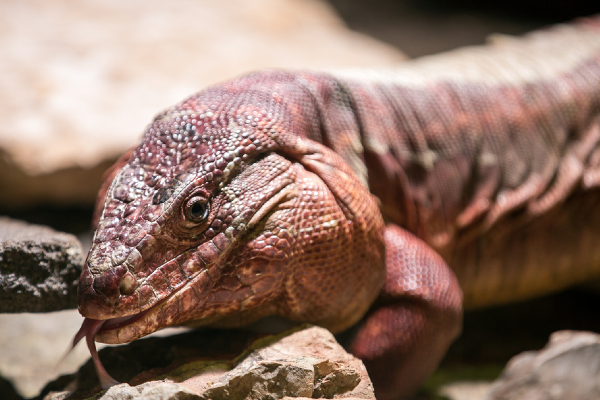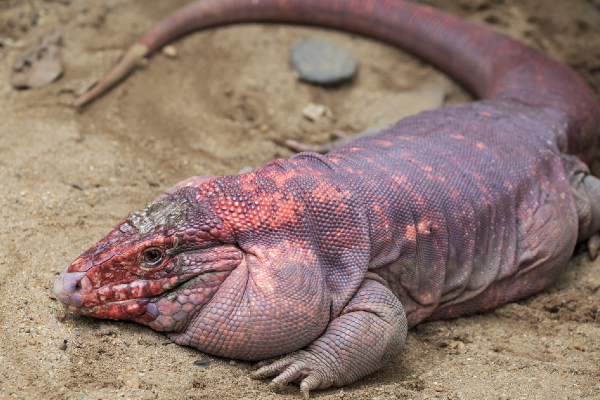Red Tegus are a type of lizard that is found in Central and South America. They are known for their bright red color, and for being one of the largest lizards in the area. While they are not typically considered to be a pet, they can make interesting pets for those who know how to care for them properly. If you’re interested in learning more about Red Tegus, or if you’re thinking of getting one as a pet, this blog post is for you!

Red Tegu Description
Red Tegus are a type of large lizard that is native to South America. They can grow up to four feet in length and have a reddish-brown coloration. Red Tegus are omnivorous, meaning they will eat both plants and animals. In the wild, they are known to eat fruits, vegetables, small mammals, and birds. captivity, they are often fed a diet of commercially-prepared lizard food, supplemented with live insects. Red Tegus are generally docile creatures that make good pets. They are intelligent and can be trained to perform simple tricks. Red Tegus typically live for 10-15 years in captivity.
Red Tegu Habitat
Red Tegus are native to South America, where they can be found in a variety of habitats, from dry forests to wet lowlands. They are most common in Brazil, but can also be found in Paraguay, Uruguay, and Argentina. Red Tegus are relatively adaptable and can even thrive in urban environments. In the wild, they typically prefer areas with a lot of cover, such as dense vegetation or rocky outcrops. This provides them with places to hide from predators and helps to keep their bodies warm. Red Tegus are also known to climb trees and dig burrows, which furthers enhances their ability to escape from predators and regulate their body temperature. As a result of their adaptability, Red Tegus have been successfully introduced to several countries outside of their native range, including the United States. While they are not considered to be a major threat to native wildlife, they can cause problems for local ecosystems by competing with native species for food and habitat.
Red Tegu Diet
Red Tegus are omnivores, and their diet includes both plants and animals. They will eat fruits, leaves, flowers, and stems, as well as insects, spiders, and small mammals. In captivity, Red Tegus can be fed a diet of commercially-prepared lizard food, as well as live food such as crickets and mealworms. It is important to provide a Red Tegu with a varied diet to ensure that they get all the nutrients they need.
Red Tegu Size
Red Tegus are a species of large predatory lizards found primarily in South America. While the size of Red Tegus varies from one individual to another, they are generally considered to be relatively large lizards – with some individuals reaching lengths of up to three feet or more. These impressive-sized reptiles have sharp teeth and powerful jaws that help them to capture and consume prey animals such as small birds, rodents, and other reptiles. Red Tegus tend to be most active during the heat of the day, when they can be found foraging for food in their natural habitats. Overall, Red Tegus are impressive creatures whose size sets them apart as key members of the animal community.
Red Tegu Lifespan
Red Tegus typically live between 10 and 15 years in captivity, though they may live slightly shorter lives in the wild. These lizards are native to South America, where they can be found in countries like Bolivia, Brazil, and Paraguay. Red Tegus are relatively large lizards, with adults reaching lengths of up to 4 feet. They are also popular pets due to their docile nature and ease of care. When properly cared for, Red Tegus can make lively and entertaining companions.

Red Tegu Behavior
Red Tegus are a species of large, predatory lizards known for their distinctive red scales and unique behavioral characteristics. These animals typically live in groups, with each individual taking responsibility for guarding its own territory as well as acting as lookout for the group when it is active. Red Tegus are also highly intelligent creatures, capable of adapting quickly to different environments and exhibiting complex social behaviors. Additionally, they are skilled hunters, using both stealth and strength to catch prey ranging from small rodents to large birds and other reptiles. Overall, Red Tegus are fascinating animals that have much to teach us about nature and behavior.
Red Tegu Speed
Red Tegus are one of the fastest lizards on Earth. They can run up to speeds of 20 miles per hour. Red Tegus are also excellent swimmers and can stay under water for up to 45 minutes. They are native to South America and can be found in countries such as Brazil, Argentina, and Uruguay. Red Tegus are omnivores and will eat just about anything they can find, including fruit, insects, small mammals, and even other lizards. The Red Tegu is an amazing creature and is definitely worth checking out if you ever have the chance!
Red Tegu Hunting
Red Tegus are large, carnivorous lizards native to South America. These unique animals have powerful jaws and sharp claws, making them a formidable predator in their natural habitat. Red Tegus are most commonly encountered by humans while they are hunting or scavenging for food. Because they are skilled hunters and highly adaptable, Red Tegus are often found near human settlements and farms, where they can easily access the livestock and crops that make up the bulk of their diet. In order to protect valuable property and domesticated animals, Red Tegu hunters need to be ever-vigilant against these clever reptiles. Successful Red Tegu hunting requires knowledge of the animal’s habits, location, and feeding patterns. With careful planning and preparation, however, Red Tegu hunting can be an effective way to keep these large predators under control in human-populated areas.
Conclusion
Red tegu lizards are a great choice for reptile enthusiasts who are looking for an animal that is relatively easy to care for and has a docile temperament. These lizards can grow up to four feet in length, so they require a fair amount of space, but they make excellent pets for those who have the means to provide them with proper care. If you’re interested in adding a red tegu to your family of reptiles, be sure to do your research before making a purchase; these lizards require specific food and housing requirements that not all pet stores carry. With the right preparation, owning a red tegu can be an enjoyable experience for both you and your lizard!
Frequently Asked Question

